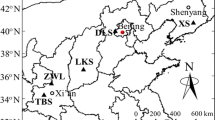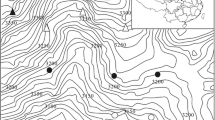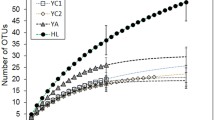Abstract
Although Quercus liaotungensis forest is an important component of Loess Plateau forest ecosystems, little is known about the ectomycorrhizal fungal (EMF) symbiosis of Q. liaotungensis in this ecosystem. Here we investigated EMF communities of Q. liaotungensis along three successional stands on the central Loess Plateau (Yan’an, China): a seedling stand (1 to 3-year-old seedlings under a Populus davidiana forest stand), a young tree stand (20 to 30-year-old Q. liaotungensis forest stand), and a mature tree stand (50 to 70-year-old Q. liaotungensis forest stand). In each stand, the Q. liaotungensis roots were sampled, then EMF communities were examined on the basis of EMF morphotyping, PCR–RFLP, and DNA sequencing. In total, 70 EMF species were observed, and the total richness of estimated species exceeded 100 EMF species. The EMF community was composed of a few common taxa (approx. 7 %) and many rare taxa (approx. 61 %). EMF richness in young and mature trees was higher than in seedlings. EMF communities of young and mature trees were more similar than those of seedlings and trees. Nonmetric multidimensional scaling ordinations of the EMF community revealed more separation among Q. liaotungensis of different age. This study provides preliminary insight into the taxonomic diversity of EMF of Q. liaotungensis along different successional stands on the Loess Plateau.


Similar content being viewed by others
References
Agerer R (1987–1998) Colour atlas of Ectomycorrhizae. Schwabisch Gmund. Einhorn-Verlag Eduard Dietenberger, Germany
Aponte C, Garcia LV, Maranon T, Gardes M (2010) Indirect host effect on ectomycorrhizal fungi: leaf fall and litter quality explain changes in fungal communities on the roots of co-occurring Mediterranean oaks. Soil Biol Biochem 42:788–796
Avis PG, McLaughlin DJ, Dentinger BC, Reich PB (2003) Long-term increase in nitrogen supply alters above- and below-ground ectomycorrhizal communities and increases the dominance of Russula spp. in a temperate oak savanna. New Phytol 160:239–253
Benucci GMN, Raggi L, Albertini E, Grebenc T, Bencivenga M, Falcinelli M, Di Massimo G (2011) Ectomycorrhizal communities in a productive Tuber aestivum Vittad. orchard: composition, host influence and species replacement. FEMS Microbiol Ecol 76:170–184
Brundrett MC (2009) Mycorrhizal associations and other means of nutrition of vascular plants: understanding the global diversity of host plants by resolving conflicting information and developing reliable means of diagnosis. Plant Soil 320:37–77
Cline ET, Ammirati JF, Edmonds RL (2005) Does proximity to mature trees influence ectomycorrhizal fungus communities of Douglas-fir seedlings? New Phytol 166:993–1009
Colwell RK (2009) EstimateS: statistical estimation of species richness and shared species from samples. Version 8.2. User’s guide and application. http://purl.oclc.org/estimates
Courty PE, Franc A, Pierrat JC, Garbaye J (2008) Temporal changes in the ectomycorrhizal community in two soil horizons of a temperate oak forest. Appl Environ Microbiol 74:5792–5801
DeBellis T, Kernaghan G, Bradley R, Widden P (2006) Relationships between stand composition and ectomycorrhizal community structure in boreal mixed-wood forests. Microb Ecol 52:114–126
Diedhiou AG, Dupouey JL, Buee M, Dambrine E, Laut L, Garbaye J (2009) Response of ectomycorrhizal communities to past Roman occupation in an oak forest. Soil Biol Biochem 41:2206–2213
Douhan GW, Rizzo DM (2005) Phylogenetic divergence in a local population of the ectomycorrhizal fungus Cenococcum geophilum. New Phytol 166:263–271
Du S, Yamanaka N, Yamamoto F, Otsuki K, Wang SQ, QC H (2007) The effect of climate on radial growth of Quercus liaotungensis forest trees in Loess Plateau, China. Dendrochronologia 25:29–36
Du S, Wang YL, Kume T, Zhang JG, Otsuki K, Yamanaka N, Liu GB (2011) Sapflow characteristics and climatic responses in three forest species in the semiarid Loess Plateau region of China. Agric For Meteorol 151:1–10
Gardes M, Bruns TD (1993) ITS primers with enhanced specificity for Basidiomycetes-application to the identification of mycorrhizae and rusts. Mol Ecol 2:113–118
Gebhardt S, Neubert K, Wollecke J, Munzenberger B, Huttl RF (2007) Ectomycorrhiza communities of red oak (Quercus rubra L.) of different age in the Lusatian lignite mining district, East Germany. Mycorrhiza 17:279–290
Glen M, Tommerup IC, Bougher NL, O’Brien PA (2001) Interspecific and intraspecific variation of ectomycorrhizal fungi associated with Eucalyptus ecosystems as revealed by ribosomal DNA PCR–RFLP. Mycol Res 105:843–858
Högberg P, Plamboeck AH, Taylor AFS, Fransson PMA (1999) Natural C-13 abundance reveals trophic status of fungi and host-origin of carbon in mycorrhizal fungi in mixed forests. PNAS 96:8534–8539
Horton TR, Molina R, Hood K (2005) Douglas-fir ectomycorrhizae in 40-and 400-year-old stands: mycobiont availability to late successional western hemlock. Mycorrhiza 15:393–403
Ishida TA, Nara K, Hogetsu T (2007) Host effects on ectomycorrhizal fungal communities: insight from eight host species in mixed conifer-broadleaf forests. New Phytol 174:430–440
Jany JL, Garbaye J, Martin F (2002) Cenococcum geophilum populations show a high degree of genetic diversity in beech forests. New Phytol 154:651–659
Jiao JY, Tzanopoulos J, Xofis P, Bai WJ, Ma XH, Mitchley J (2007) Can the study of natural vegetation succession assist in the control of soil erosion on abandoned croplands on the Loess Plateau, China? Restor Ecol 15:391–399
Jiao JY, Tzanopoulos J, Xofis P, Mitchley J (2008) Factors affecting distribution of vegetation types on abandoned cropland in the hilly-gullied Loess Plateau region of China. Pedosphere 18:24–33
Jonsson L, Dahlberg A, Nilsson MC, Zackrisson O, Karen O (1999) Ectomycorrhizal fungal communities in late-successional Swedish boreal forests, and their composition following wildfire. Mol Ecol 8:205–215
Korkama T, Pakkanen A, Pennanen T (2006) Ectomycorrhizal community structure varies among Norway spruce (Picea abies) clones. New Phytol 171:815–824
Leski T, Pietras M, Rudawska M (2010) Ectomycorrhizal fungal communities of pedunculate and sessile oak seedlings from bare-root forest nurseries. Mycorrhiza 20:179–190
Liu GS, Jiang NH, Zhang LD (1996) Standard methods for observation and analysis in chinese ecosystem research network: soil physical and chemical analysis and description of soil profiles. Standards Press of China, Beijing
Matsuda Y, Hijii N (1999) Characterization and identification of Strobilomyces confusus ectomycorrhizas on Momi fir by RFLP analysis of the PCR-amplified ITS region of the rDNA. J For Res 4:145–150
McCune B, Mefford MJ (1999) 1995–2002 multivariate analysis of ecological data, version 4. MJM Software Design, USA
Meng FR, Tang XJ (2001) Study on the promotion effects of mycorrhizae to Populus davidiana seedlings. Mycosystema 20:552–555 (in Chinese)
Morris MH, Smith ME, Rizzo DM, Rejmanek M, Bledsoe CS (2008) Contrasting ectomycorrhizal fungal communities on the roots of co-occurring oaks (Quercus spp.) in a California woodland. New Phytol 178:167–176
Nara K, Nakaya H, Hogetsu T (2003) Ectomycorrhizal sporocarp succession and production during early primary succession on Mount Fuji. New Phytol 158:193–206
Richard F, Millot S, Gardes M, Selosse MA (2005) Diversity and specificity of ectomycorrhizal fungi retrieved from an old-growth Mediterranean forest dominated by Quercus ilex. New Phytol 166:1011–1023
Richard F, Roy M, Shahin O, Sthultz C, Duchemin M, Joffre R, Selosse MA (2011) Ectomycorrhizal communities in a Mediterranean forest ecosystem dominated by Quercus ilex: seasonal dynamics and response to drought in the surface organic horizon. Ann For Sci 68:57–68
Rudawska M, Leski T, Stasinska M (2011) Species and functional diversity of ectomycorrhizal fungal communities on Scots pine (Pinus sylvestris L.) trees on three different sites. Ann For Sci 68:5–15
Simard SW, Perry DA, Jones MD, Myrold DD, Durall DM, Molina R (1997) Net transfer of carbon between ectomycorrhizal tree species in the field. Nature 388:579–582
Smith SE, Read DJ (2008) Mycorrhizal symbiosis. Academic Press, San Diego
Smith ME, Douhan GW, Rizzo DM (2007) Ectomycorrhizal community structure in a xeric Quercus woodland based on rDNA sequence analysis of sporocarps and pooled roots. New Phytol 174:847–863
Tedersoo L, May TW, Smith ME (2010) Ectomycorrhizal lifestyle in fungi: global diversity, distribution, and evolution of phylogenetic lineages. Mycorrhiza 20:217–263
Toljander JF, Eberhardt U, Toljander YK, Paul LR, Taylor AFS (2006) Species composition of an ectomycorrhizal fungal community along a local nutrient gradient in a boreal forest. New Phytol 170:873–883
Twieg BD, Durall DM, Simard SW (2007) Ectomycorrhizal fungal succession in mixed temperate forests. New Phytol 176:437–447
Twieg BD, Durall DM, Simard SW, Jones MD (2009) Influence of soil nutrients on ectomycorrhizal communities in a chronosequence of mixed temperate forests. Mycorrhiza 19:305–316
Visser S (1995) Ectomycorrhizal fungal succession in jack pine stands following wildfire. New Phytol 129:389–401
Walker JF, Miller OK, Horton JL (2005) Hyperdiversity of ectomycorrhizal fungus assemblages on oak seedlings in mixed forests in the southern Appalachian Mountains. Mol Ecol 14:829–838
Wang J, Fu BJ, Qiu Y, Chen LD (2003) Analysis on soil nutrient characteristics for sustainable land use in Danangou catchment of the Loess Plateau, China. Catena 54:17–29
Wang Q, He XH, Guo LD (2012) Ectomycorrhizal fungus communities of Quercus liaotungensis Koidz of different ages in a northern China temperate forest. Mycorrhiza 22:461–470
Wang YL, Liu GB, Kume T, Otsuki K, Yamanaka N, Du S (2010) Estimating water use of a black locust plantation by the thermal dissipation probe method in the semiarid region of Loess Plateau, China. J For Res 15:241–251
White TJ, Bruns TD, Lee S, Taylor J (1990) Amplification and direct sequencing of fungal ribosomal RNA genes for phylogenetics. In: Innis MA, Gelfand DH, Sninsky JJ, White TJ (eds) PCR protocols: a guide to methods and applications. Academic Press, New York
Wu QX, Yang WZ (1998) Forest and grassland vegetation construction and its sustainable development in Loess Plateau. Science Press, Beijing (in Chinese)
Zhang J, Taniguchi T, Tateno R, Xu M, Du S, Liu GB, Yamanaka N (2013) Ectomycorrhizal fungal communities of Quercus liaotungensis along local slopes in the temperate oak forests on the Loess Plateau, China. Ecol Res 28:297–305
Zhu ZC (1993) Recovering succession of vegetation in forest region of Shaanxi Loess Plateau. J Northwest For Coll 8:87–94 (in Chinese)
Acknowledgments
We are grateful to Dr Ryunosuke Tateno for selection of sites and to Wei-Yu Shi for help in the field. We would also like to thank two anonymous reviewers for their constructive comments on the original draft of this paper. This work was supported by the Japan Society for the Promotion of Science through the Core University Program and the Global COE Program: Global Center of Excellence for Dryland Science.
Author information
Authors and Affiliations
Corresponding author
Electronic supplementary material
Below is the link to the electronic supplementary material.
About this article
Cite this article
Zhang, J., Taniguchi, T., Xu, M. et al. Ectomycorrhizal fungal communities of Quercus liaotungensis along different successional stands on the Loess Plateau, China. J For Res 19, 395–403 (2014). https://doi.org/10.1007/s10310-013-0433-y
Received:
Accepted:
Published:
Issue Date:
DOI: https://doi.org/10.1007/s10310-013-0433-y




